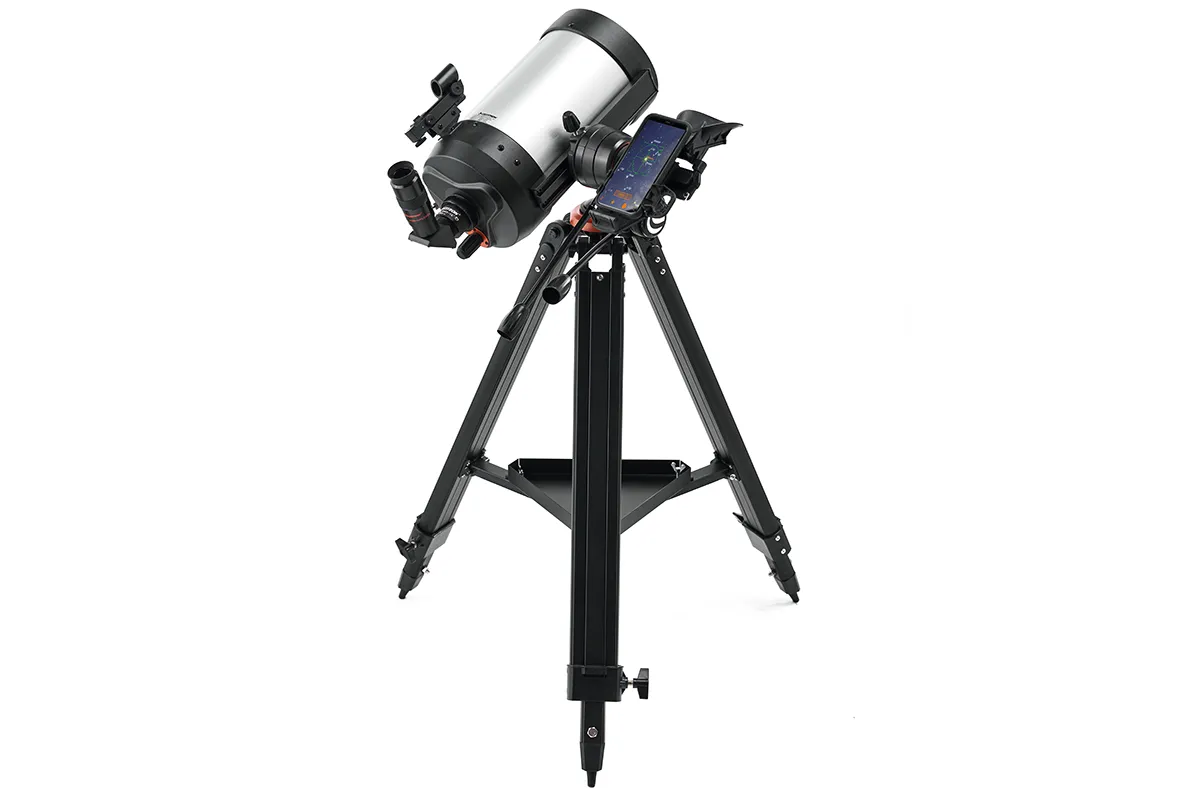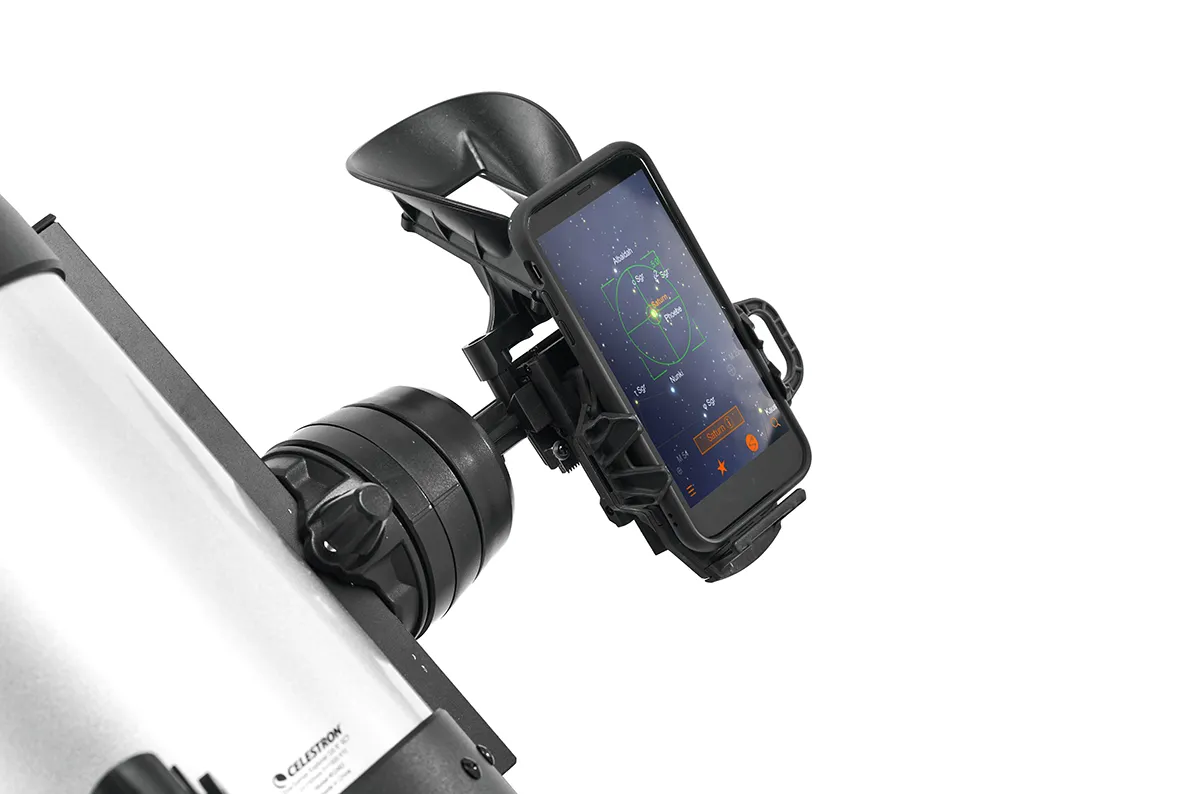Do you fancy having Go-To functionality without the hassle of motorised drives and a complex equatorial or altaz mount that costs a fortune?
Well, this is where Celestron’s StarSense range comes into its own. By employing a clever app on your smartphone, combined with a carefully designed adaptor to hold it, the StarSense series does just that.
As the StarSense Explorer DX 6-inch Schmidt-Cassegrain is currently the largest and latest offering in the series, we were keen to try it out.
- Buy now from Picstop

The StarSense Explorer DX 6 is a 6-inch (150mm) Schmidt-Cassegrain telescope, which uses a primary mirror at the rear, and a corrector plate and secondary mirror at the front to fold the light path into a short tube.
It has a focal length of 1,500mm, giving a focal ratio of f/10, and the tube is only 406mm long making it quite compact.
It is mounted on a basic yet effective manual ‘Push-To’ altaz mount; while slow-motion controls allow you to make fine-tuning adjustments to the position of the telescope, it can also be moved by hand for rough alignment.
The mount also houses the smartphone adaptor/phone dock; when you are using the downloadable StarSense Explorer app (more on this below) this enables you to align your smartphone with where the telescope is pointing.
The accompanying black aluminium tripod has ample leg adjustment to put the telescope at a convenient height to use with a basic yet effective spreader accessory tray.

The StarSense Explorer DX 6 is supplied with two eyepieces, 40mm and 10mm, which give magnifications of 38x and 150x respectively, while an erect image star diagonal and simple red dot finder complete the setup.
Unlike the refractor models in the StarSense range, the Explorer DX 6 mount has the smartphone adaptor placed on the other side of the support arm to the telescope, so it moves in sync with the scope when you adjust the altitude.
With our iPhone XR docked and using the StarSense Explorer app, we first had to perform a simple, one-off alignment procedure during daytime to ensure the phone’s camera was lined up and looking at the mirror on the adaptor.
This is key to ensuring the planetarium aspect of the app can plate-solve the night sky and provide accurate target locations and aiming directions.
Once activated, you just keep the telescope pointing at a part of the night sky that is unobstructed and it determines where it is pointing.
Next, you can either tap a target on the displayed sky map or go into the menu and select a target from a suitable list, following the on-screen prompts to move the scope to it.

We took a tour of the galaxies of M81 and M82, which fit nicely in the field of view of the 40mm eyepiece.
Switching to the 10mm eyepiece, M82 appeared as a broken sliver of light, while M81 was an oval glow.
In the north we located the Double Cluster, which was nicely framed in the 40mm eyepiece with a sprinkling of orange stars between its two open clusters.
Nearby was a favourite open cluster, M103, which lost none of its splendour in the 10mm eyepiece.
Indeed, the 10mm came into its own on double and multiple stars as we took in the coloured double of Albireo (Beta (β) Cygni), with its golden yellow primary and sky-blue companion.
The triple star Iota (ι) Cassiopeiae could just be resolved and the ‘double-double’ star of Epsilon (ε) Lyrae had both sets of stars split cleanly with the 10mm.
The Dumbbell Nebula, M27, was impressive with the 40mm eyepiece, while the Ring Nebula, M57, showed a dark centre with the 10mm.
Although we had no planets on view due to local horizon obstructions, we were rewarded with plenty of detail on the Moon.
It is worth noting that the StarSense Explorer app only works at night when it can plate-solve using the stars, but you can use its star pointer finder to line up on obvious targets such as the Moon in the daytime.
Overall, we found the StarSense Explorer DX 6 proved to be an enjoyable experience to use.
How the StarSense phone adaptor works

The StarSense adaptor/phone dock lies on the other side of the mounting arm to the telescope, and this lines up perfectly with the direction the telescope is pointing.
Simply download the StarSense Explorer app from Google Play or the Apple app store and insert your smartphone in the holder.
When the app starts up you can align the smartphone with the telescope, which is best done in the daytime on a distant target for accurate alignment.
The adaptor positions your smartphone over a mirror, allowing its camera to ‘see’ the night sky.
The app is very effective and is at the core of the StarSense system; it plate- solves the view of the sky the phone camera sees and works out where it is pointing.
This allows the planetarium aspect of the app to show you the way via onscreen arrows to a target (below, left)
Move the scope manually until you are almost on target, leave the scope to refine its position, then you can fine tune the position so the indicator box turns green when you’re on target. There is also a red light night mode (below, right).

Celestron StarSense Explorer DX 6-inch: outstanding features
1
Optics
The StarSense Explorer DX 6 optics comprise a 150mm-diameter mirror and front corrector lens with a focal length of 1,500mm, giving a focal ratio of f/10. The corrector lens is multi-coated to improve light transmission for brighter, crisper views of a wide variety of targets, from the Moon to the deep sky.
2
Optical tube
The optics are housed in an aluminium tube measuring 406mm in length and 184mm in diameter, while the whole optical tube assembly weighs only 4.54kg, making it relatively light, portable and easy to attach to the mount. It has a stylish silver and black finish.
3
Accessories
Two 1.25-inch eyepieces of 40mm and 10mm are provided, giving magnifications of 38x and 150x, along with an erect- image star diagonal that is useful in an altaz system. A StarPointer red dot finder is also provided and this helps with initial alignment, after which you can use the StarSense Explorer app.
4
Tripod
The black, aluminium tripod is light, weighing just 1.72kg, and extends to a maximum height of 1.32m, which gives a good range of adjustment. It comes with a simple but useful accessories tray that can take the eyepieces and other accessories, keeping them handy for use.
5
Mount
The mount is a single-arm altaz design allowing manual movement up, down and side to side. There are two slow-motion controls for fine-tuning the altitude and azimuth position. Rough positional adjustment is done by manually pushing the system by hand. The telescope is attached via a Vixen-style CG5 bar.
Vital stats
- Price £699
- Optical design Schmidt-Cassegrain
- Optics 150mm
- Focal length 1,500mm, f/10
- Mount Manual altaz mount with slow-motion controls
- App control StarSense Explorer app with StarSense Sky Recognition Technology and planetarium
- Extras StarSense dock for your smartphone, 40mm and 10mm eyepieces, star diagonal, StarPointer red dot finderscope
- Weight 6.35kg
- Supplier Celestron
- Tel 0118 467 1200
- www.celestron.com
Read more reviews of Celestron telescopes:
- Celestron Omni XLT 127 telescope
- Celestron Omni XLT 150 R
- Celestron Advanced VX 700 Maksutov-Cassegrain
- Celestron CGEM DX 1400 HD
This review originally appeared in the August 2021 issue of BBC Sky at Night Magazine.

